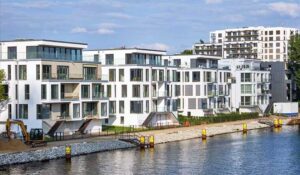
In recent years, Albania has transformed from a “hidden beach destination” into one of the most dynamic real estate markets in the Mediterranean. In 2024, foreigners invested around €380 million in Albanian real estate — 17% more than in 2023. This is the third consecutive year that real estate has ranked first in terms of attracting foreign investment, accounting for around 24% of total FDI inflows.
According to a study by the Experts Club information and analytical center, in recent years, foreigners have accounted for about a quarter of all home purchase and sale transactions in Albania. Most of the interest is concentrated on the coast — Saranda, Ksamil, Vlora, Durres, and the vicinity of Tirana. Below is an informal top 10 list of countries whose citizens are most actively investing in real estate in Albania: Italians — their “own” Riviera at half the price. Italians were among the first to discover Saranda and Ksamil. Demand from Italy has doubled in recent years, especially for apartments by the sea.
Poles, Czechs, and Slovaks — investors focused on profitability. These buyers account for up to 90% of demand in some resort areas, investing in small apartments for daily rent with an expected ROI of 10-16%.
Germans and Swiss are looking for stability and quality. They prefer the “quiet” segment on the coast and in Tirana, with good infrastructure and stable rental income.
Scandinavians appreciate Albania’s climate and nature.
Norway, Sweden, and Finland are also actively buying real estate, choosing high standards of living at moderate prices.
The French and British are “latecomers” but active. Interest in Albania from these countries is growing, attracting them with relatively low prices compared to southern France and Spain.
Americans are betting on “early entry.” Albania remains a “new” destination for Americans, with growing interest in villas and large apartments.
Ukrainians are a growing but niche segment. After 2022, interest from Ukraine has grown significantly, and Ukrainians prefer the coast for relocation and obtaining a residence permit.
Russians and other post-Soviet investors — due to sanctions pressure, their share has decreased, but interest still remains, especially through companies and relatives.
Citizens of Kazakhstan and Belarus continue to invest actively, especially on the coast and in large cities.
Other EU countries are actively buying on the south coast, especially during the high tourist season.
Why Albania attracts foreign investors:
Free access to housing. Foreigners can freely buy apartments, houses, and commercial real estate, with the exception of agricultural land.
High profitability and price growth. Annual rental yields on the coast can reach 7% and above, and in peak tourist locations — up to double digits.
Strong investment flow. In 2024, foreign investment in real estate amounted to approximately €380 million, and in the second quarter of 2025, this figure reached a record €149 million.
Residence permit and “life package.” Laws on foreigners allow you to obtain a residence permit based on investment in housing.
Risks and prospects: The sharp influx of foreign investors is already leading to higher housing prices for the local population. However, Albania remains an EU candidate country with large-scale infrastructure projects (a new airport in Vlora, reconstruction of the port in Durres), which supports long-term demand for housing.
Despite growing competition in the market, Albania retains its potential as “Europe’s last affordable Riviera,” making it attractive to investors, but professional legal due diligence and an understanding of real returns are required to enter the market.

According to Eurostat data on material deprivation in the “Housing in Europe – 2025 edition” review, around 9% of the European Union population in 2024 could not afford to heat their homes adequately.
The EU’s statistical office notes that the problem of energy poverty and high utility costs remains significant for millions of households, despite the support measures taken after the 2022–2023 energy crisis.
Low-income households and residents of old, energy-inefficient housing in a number of Eastern and Southern European countries remain particularly vulnerable.

One in six residents of the European Union lives in cramped housing, while approximately one in three lives in a household that is considered too spacious for the number of residents, according to Eurostat’s overview publication ‘Housing in Europe – 2025 edition’.
According to the statistics agency’s estimates, in 2024, about 17% of the EU population lived in overcrowded housing. The highest rates of ‘overcrowding’ were recorded in Romania (41%), Latvia (39%) and Bulgaria (34%).
The lowest rates of overcrowded housing were recorded in Cyprus (2%), Malta (4%) and the Netherlands (5%).
At the same time, about 33% of the EU population lives in ‘underoccupied’ housing – houses and flats that are considered too large for the number of people living in them.
The highest proportion of such households is in Cyprus (70%), Ireland (67%) and Malta (64%), and the lowest in Romania (7%), Latvia (10%) and Greece (13%).

The proportion of European Union residents living in their own homes in 2024 was 68%, while 32% of the population rented a house or apartment, according to the interactive review “Housing in Europe – 2025 edition” by the EU statistical office Eurostat.
According to the data, the highest rates of home ownership were recorded in Romania (94% of the population live in their own homes), Slovakia (93%), Hungary (92%), and Croatia (91%). The only EU country where the majority of the population prefers to rent is Germany, where 53% of residents are tenants. In Austria, the share of tenants is 46%, and in Denmark, it is 39%.
Eurostat notes that in all EU countries except Germany, ownership remains the dominant form of housing, although in large cities and capitals, the proportion of rentals is traditionally higher than in small towns and rural areas.

In January-November 2025, the Croatian residential real estate market cemented its status as one of the most expensive and dynamically growing in the EU. Official statistics and private research show double-digit price growth amid a slowdown in the number of transactions and an increased role of the state in addressing the issue of housing affordability.
According to the State Statistics Office (DZS), the average price per square meter of new housing in Croatia in the first half of 2025 was €2,754. This is approximately 15.9% more than in the first half of 2024 and 5.3% higher than in the second half of 2024.
By region. – Zagreb: around €2,958 per square meter (+4.5% year-on-year), rest of Croatia: around €2,511 per square meter, with growth in these cities and towns reaching 22% over the year, reflecting the rapid rise in housing prices in coastal and tourist regions.
The House Price Index shows that in the second quarter of 2025, residential property prices rose by 4.4% compared to the previous quarter and by 13.2% compared to the same period in 2024. According to Eurostat, this is one of the highest figures in the EU in terms of quarterly and annual growth.
According to market analysts’ estimates, the average price of housing (including secondary housing) in the fall of 2025 approached €2,800–2,900 per square meter across the country, which is approximately 70–80% higher than in 2020. At the same time, the average price of apartments is estimated at over €3,800–4,100 per square meter, while houses are slightly cheaper.
Market data shows that the gap between the coast and inland regions is widening:
In Split, the average asking price in October 2025 reached around €5,315 per square meter, almost 15% more than a year earlier.
In Dubrovnik, an apartment costs on average more than €4,100 per square meter, and in prestigious locations, the range is €5,000–7,000 and above.
In Istria and popular locations in Central and Southern Dalmatia, typical prices range from €3,500 to €7,000 per square meter, depending on the class of the property and its proximity to the sea.
Inland regions (e.g., Slavonia) remain significantly cheaper, often in the range of €1,000–2,000 per square meter.
In Zagreb, the average price for apartments is estimated at around €3,400–3,500 per square meter, but there is a significant gap between districts within the city. Analysis of private listings shows that the central and “tram” areas of the capital are significantly more expensive than the suburbs.
A separate trend in 2025 is stagnation and even a slight decline in house prices in some segments. According to one of the largest ad portals, the average price of houses in Zagreb in the middle of the year was around €1,200 per square meter, with price growth slowing more sharply than for apartments.
Despite high prices, the market has not yet shown a full correction. Some analytical reviews note a decline in the number of transactions in the first half of 2025, but this has had virtually no impact on price levels, especially in coastal regions, where supply remains limited.
At the same time, rising interest rates and tighter mortgage lending conditions, which began in 2023–2024, are limiting the options for some households, especially young families. In 2025, the Croatian National Bank tightened macroprudential requirements for banks and mortgage loans in an effort to curb overheating in the housing market and risks to financial stability.
According to Arvio’s report for the first quarter of 2025, foreigners accounted for about 7.19% of all real estate transactions in Croatia. The most active buyers were:
citizens of Slovenia – approximately 30.2% of foreign transactions,
Germany – approximately 21.1%,
Austria – approximately 10.4%.
The total number of transactions involving foreigners has been declining for the third consecutive year: an estimated 13,300 in 2022, 12,300 in 2023, and 11,600 in 2024.
Foreigners traditionally concentrate on the Adriatic coast (Istria, Kvarner, Dalmatia) and the islands, where new apartments and houses ready for immediate occupancy or rental are in demand. It is external demand, combined with limited supply, that largely supports the high and rising price level.
The sharp rise in prices and the decline in housing affordability prompted the government to adopt the first comprehensive National Housing Policy Plan until 2030 in 2025.
Key facts on which the document is based:
there are about 2.39 million housing units in the country, with about 40% not used for permanent residence,
over the past five years, the price of new apartments has increased by approximately 54%,
young families face difficulties in accessing mortgages and a shortage of affordable housing.
In fact, the state is trying to simultaneously cool down overheated market segments and expand the supply of affordable apartments, especially in the medium and long-term rental market.
Based on statistics for the first three quarters and market participants’ expectations, the baseline scenario for the end of 2025 and 2026 is as follows:
Prices will continue to rise, but at a slower pace than the double-digit rates seen in 2023-2024. Already in the second half of 2025, some analysts are noting a slowdown in growth, especially in the housing segment and in regions far from the sea.
The gap between the coast and inland regions will remain: tourist and premium locations will become more expensive faster, while “continental” Croatia will remain relatively affordable, which may support internal migration and local demand.
According to analysts’ estimates, the share of foreign buyers will remain at around 8% of all transactions by the end of 2025 or will decline slightly due to high prices and affordability issues.
The implementation of the National Housing Plan until 2030 will play an important role, including the launch of affordable rental programs, the activation of vacant housing stock, and the adjustment of subsidized home purchase programs.
For Croatia, where real estate has become a key tool for household savings and an object of interest for foreign capital, the coming years will be a test of its ability to combine the goals of economic growth, tourism development, and ensuring basic housing affordability for its own citizens.

The housing price index in Ukraine for July-September 2025 stands at 112%, while for the same period in 2024, the figure was 111.7%, according to the State Statistics Service (SSS).
According to its data, in the primary market, housing prices slowed their growth to 12.8% in the third quarter of 2025, compared to 14.1% in the third quarter of last year. One-room apartments saw the highest price increase — 13.3%. The price increase for two-room apartments was 13.3%, and for three-room apartments – 11.7%.
In contrast, prices in the secondary market accelerated their growth to 11.5% in July-September 2025, compared to 10.5% in the same period of 2024. One-room apartments rose in price by 12.5%, and two- and three-room apartments by 11.4%.
According to the statistics agency, compared to the previous quarter, housing prices rose by 0.3%, with the primary market rising by 0.2% and the secondary market by 0.3%.
According to the State Statistics Service, in the third quarter of 2025, prices in the primary market rose by 9.1% for one-room apartments compared to the fourth quarter of 2024, by 8% for two-room apartments, and by 7.4% for three-room apartments. In the secondary market, they rose by 9.1%, 7.8%, and 7.6%, respectively.
Overall, housing prices rose by 12.7% in the first three quarters compared to the same period last year. In the primary market, the increase was 14.8%, and in the secondary market, it was 11.6%.
As reported, according to the State Statistics Service, housing prices in 2024 rose by 12.7%.
The State Statistics Service noted that the figures do not include temporarily occupied territories and parts of territories where hostilities are (were) ongoing.